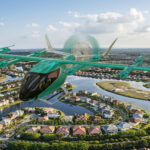The Connected Places Summit is taking place in London in March in an effort to harness the ingenuity, innovation, and collaboration of attendees, and to accelerate innovation. Andrew Chadwick, ecosystem director – air mobility and airports at Connected Places Catapult, spoke to FINN about the event.
What do you hope to achieve from the Connected Places Summit?
This is our first Connected Places Summit, and we’re excited as it will harness the collective ingenuity, innovation, and collaboration of our community to Accelerate Innovation, Together. We’re planning for over 2000 attendees (60% decision-makers and 40% innovators) from 500 leading organisations.
The event will feature interactive content, live project showcases, inspiring thought leadership and opportunities to connect with peers from technology, transport, mobility, cities, academia, investment, and Government. Our overarching event themes include place leadership, connected intelligence, transport & mobility, and climate action.
What are the defining challenges for the aerospace sector?
Decarbonisation, Connectivity and Accessibility are our strategic themes within our Air Mobility & Airports practice and drive everything we do. We are committed to zero emission flight and supporting infrastructure, we believe in equity of accessibility for all air passengers, plus we recognise that digital connectivity is a key enabler for more efficient and effective operations and service.
Aviation is currently responsible for around 2.5% of global carbon dioxide (CO2) emissions and is growing. If this not addressed now, aviation emissions are anticipated to account for almost 50% of global emissions by 2050.
Therefore, our work in Connected Places Catapult seeks to address this challenge in the short and long term, by promoting zero carbon technologies, delivering a roadmap of innovations and initiatives to lower carbon emissions, and convening the industry to drive forward an ambitious zero carbon agenda.
A focus on accessibility needs should be grounded in a fundamental right that all travellers are able to access air travel. This is laid out by the EC regulation 1107/2006, the law still adopted by the UK, which states that: “the single market for air services should benefit citizens in general. Consequently, disabled persons and persons with reduced mobility, whether caused by disability, age or any other factor, should have opportunities for air travel comparable to those of other citizens. Disabled persons and persons with reduced mobility have the same right as all other citizens to free movement, freedom of choice and non-discrimination. This applies to air travel as to other areas of life.”
Improving accessibility provision at UK airports has one primary benefit: that travellers are more able to seamlessly pass through an airport taking advantage of all the shops and facilities whilst on their way to board. In turn, this improves passenger experience by reducing stress and anxiety. There are wider social benefits from opening up the opportunity to fly, plus economic benefits ranging from optimising operational efficiency, boosting brand perception and increasing revenue. In addition, significantly for the Catapult, there is market benefit, sharing the potential for a vibrant market to emerge for solutions that enhance accessibility for all.
Finally connectivity. Advanced Air Mobility (AAM) is a key part of the future of aviation. Emerging technologies and innovation trends point to a future of changes in the aviation ecosystem, including regional electric and hydrogen-powered flights which will become more affordable to the wider public to use for multiple applications, AAM services will be integrated into existing transport networks such as the public transport system to improve network efficiency, plus it will improve connectivity between rural areas and urban centres, with potential to reduce road congestion and improve efficiency across the transport network.
What progress might we see in 2024 in terms of tackling those issues?
We will see the publication of the Jet Zero Council Zero Emission Flight Delivery Group Action Plan, which Connected Places Catapult has been helping to develop, in 2024. This will detail the actions we need to take – across aircraft, infrastructure, regulation and commercialisation – to drive forward the ambition of zero emission flight. In addition, Connected Places Catapult in partnership with the Department for Transport are developing a R&D programme for Zero Emission Airports that will see the adoption of zero emission technologies and innovations in airports at pace to deliver our zero carbon goals.
We will see the Future Flight Challenge Phase 3 projects deliver their demonstration programmes. We will witness drones delivering medical supplies and samples across our cities, we will see an electric vertical take-off and landing aircraft (eVTOL) demonstration into Heathrow Airport, plus a wide variety of other emerging aviation technology demonstrations. Importantly, the public will get the opportunity to see these exciting developments for the first time in the UK.
Finally, Connected Places Catapult will be showcasing technology demonstrations that will provide more inclusive passenger accessibility, non-intrusive security technologies in an airport in real-time, plus developing programmes to demonstrate airside automation and robotics, plus multi-modal net-zero surface-level access throughout 2024.
FINN has secured a 50% discount on tickets to the Connected Places Summit for the first 20 FINN readers to register for a standard pass. Use code FINN50 at checkout.

